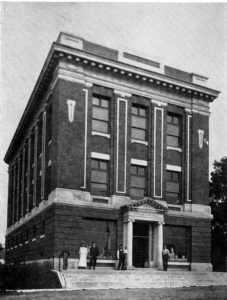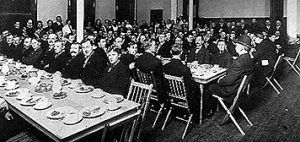Organization and Operation “Under Dispensation” — View Yearly Summaries
(adapted from the original 1937 history)
 The old Broad Ripple school house near the park was the meeting place on January 1, 1902 of a number of Master Masons who held memberships in neighboring lodges and in who had begun to take root a desire for a lodge at home where they might assemble with greater convenience and more neighborly association. At this time Broad Ripple was a flourishing little town, popular on Sundays with Indianapolis residents because of its park, fishing facilities and rural attractions. Well remembered are the town constable, the justice of the peace, the town lockup, the hand operated fire department, and the old street car waiting station which then stood on the site of what is today a modern drug store. During several meetings, plans were laid for the formation of a lodge, and finally a petition for dispensation to organize and operate Broad Ripple Lodge, U.D., Free and Accepted Masons, was presented to the grand lodge of Indiana. Light’s Eldorado hall, which was located on the second floor of a building on the northwest corner of what is now Sixty-third and Bellefontaine streets,1 was designated as the meeting place for the new lodge. Light’s Eldorado Hall The committee appointed to draft By-Laws under which the Lodge was to conduct its affairs, consisted of Brothers Arthur Jackson, Morton B. Dawson, and John D. Sullivan. The committee functioned with zeal and interest and on May 12, 1902 the results of their labor were formally adopted by the Lodge. The petition, dated May 12, 1902, named Dr. Joseph W. Bates as worshipful master; Hugh A. Cummings, senior warden, and Arthur Jackson, junior warden. Other names on the petition were Morton P. Dawson, John D. Sullivan, John L. Compton, Frank E. Watts, Benjamin J. White, Louis Schetter, Oliver J. Purcell, Clarence L. Kirk, Dr. Robert C. Light, Benjamin F. Osborn, Charles O. Johnson, James M. Watts, Daniel W. Harcourt, William Bosson, Charles O. Culbertson, James P. Johnson, Thomas P. Hessong, and Charles W. Heady. Dispensation to operate a lodge was granted on March 7, 1902, by Orlando W. Brownback, grand master. Of these named in the petition, Hugh A. Cummings and Louis Schetter did not demit from their mother lodges, and their names were deleted from the roster. The lodge immediately started to function in active ritualistic work; petitions were numerous; and before the granting of a charter, several petitioners had received the third degree and were, therefore, legally included among the charter members of the lodge. They were John B. Haverstick, Larue Heady, Charles F. Whitinger, Abraham H. Bowen, Charles Dawson, Jr., Albert Newby, and James M. Heaton. While the lodge was yet working under dispensation, it was visited by a committee of three, appointed by the grand lodge, who made an inspection and investigation of the workings and proceedings of the lodge. A copy of their report may be found in the grand lodge proceedings of 1902. Certain errors concerning irregularities of petitions and balloting were pointed out, and the by-laws were described as being “too voluminous.” However, the lodge was praised for its ritualistic work, its financial condition, and its general progress, and the granting of a charter was recommended.
The old Broad Ripple school house near the park was the meeting place on January 1, 1902 of a number of Master Masons who held memberships in neighboring lodges and in who had begun to take root a desire for a lodge at home where they might assemble with greater convenience and more neighborly association. At this time Broad Ripple was a flourishing little town, popular on Sundays with Indianapolis residents because of its park, fishing facilities and rural attractions. Well remembered are the town constable, the justice of the peace, the town lockup, the hand operated fire department, and the old street car waiting station which then stood on the site of what is today a modern drug store. During several meetings, plans were laid for the formation of a lodge, and finally a petition for dispensation to organize and operate Broad Ripple Lodge, U.D., Free and Accepted Masons, was presented to the grand lodge of Indiana. Light’s Eldorado hall, which was located on the second floor of a building on the northwest corner of what is now Sixty-third and Bellefontaine streets,1 was designated as the meeting place for the new lodge. Light’s Eldorado Hall The committee appointed to draft By-Laws under which the Lodge was to conduct its affairs, consisted of Brothers Arthur Jackson, Morton B. Dawson, and John D. Sullivan. The committee functioned with zeal and interest and on May 12, 1902 the results of their labor were formally adopted by the Lodge. The petition, dated May 12, 1902, named Dr. Joseph W. Bates as worshipful master; Hugh A. Cummings, senior warden, and Arthur Jackson, junior warden. Other names on the petition were Morton P. Dawson, John D. Sullivan, John L. Compton, Frank E. Watts, Benjamin J. White, Louis Schetter, Oliver J. Purcell, Clarence L. Kirk, Dr. Robert C. Light, Benjamin F. Osborn, Charles O. Johnson, James M. Watts, Daniel W. Harcourt, William Bosson, Charles O. Culbertson, James P. Johnson, Thomas P. Hessong, and Charles W. Heady. Dispensation to operate a lodge was granted on March 7, 1902, by Orlando W. Brownback, grand master. Of these named in the petition, Hugh A. Cummings and Louis Schetter did not demit from their mother lodges, and their names were deleted from the roster. The lodge immediately started to function in active ritualistic work; petitions were numerous; and before the granting of a charter, several petitioners had received the third degree and were, therefore, legally included among the charter members of the lodge. They were John B. Haverstick, Larue Heady, Charles F. Whitinger, Abraham H. Bowen, Charles Dawson, Jr., Albert Newby, and James M. Heaton. While the lodge was yet working under dispensation, it was visited by a committee of three, appointed by the grand lodge, who made an inspection and investigation of the workings and proceedings of the lodge. A copy of their report may be found in the grand lodge proceedings of 1902. Certain errors concerning irregularities of petitions and balloting were pointed out, and the by-laws were described as being “too voluminous.” However, the lodge was praised for its ritualistic work, its financial condition, and its general progress, and the granting of a charter was recommended.
CHARTERING AND SUBSEQUENT OPERATION
(adapted from the 50th Anniversary Program through 1952, and thereafter from material written by Christopher L. Hodapp, P.M., for the lodge website)
 Dispensation was granted by Grand Master Orlando W. Brownback on March 7, 1902, and the first meetings were held in Light’s Eldorado Hall, on the northwest corner of what is now Broad Ripple Avenue and Guilford. (The building was later the home of Abigail’s dress shop for many years, and still stands today.)
Dispensation was granted by Grand Master Orlando W. Brownback on March 7, 1902, and the first meetings were held in Light’s Eldorado Hall, on the northwest corner of what is now Broad Ripple Avenue and Guilford. (The building was later the home of Abigail’s dress shop for many years, and still stands today.)
In those days, the area actually consisted of two separate villages separated by the river – Broad Ripple to the north, and Wellington to the south. There had been an intense and often unpleasant rivalry between the two villages that had developed since the 1860’s, and two institutions eventually helped to unite the two sides: the Post Office insisting on building only one station for the area, and the formation of the Broad Ripple Masonic Lodge.
On May 28, after working under dispensation for a period of 81 days, the lodge was granted a charter designating it as Broad Ripple Lodge No. 643, Free and Accepted Masons.  The charter was granted by Orlando W. Brownback, Grand Master; James W. Dewbar, Deputy Grand Master; W. E. English, Junior Grand Warden; and Calvin W. Prather, Grand Secretary. The first three principal officers of the Lodge were Benjamin F. Osborn, Worshipful Master; Arthur Jackson, Senior Warden; and Charles O. Johnson, Junior Warden. On June 20 of that year, Brother George T. Blue, a brother of Mystic Tie Lodge of Indianapolis, presented the newly-chartered Lodge with a Holy Bible, which was used for many years and then carefully preserved.2
The charter was granted by Orlando W. Brownback, Grand Master; James W. Dewbar, Deputy Grand Master; W. E. English, Junior Grand Warden; and Calvin W. Prather, Grand Secretary. The first three principal officers of the Lodge were Benjamin F. Osborn, Worshipful Master; Arthur Jackson, Senior Warden; and Charles O. Johnson, Junior Warden. On June 20 of that year, Brother George T. Blue, a brother of Mystic Tie Lodge of Indianapolis, presented the newly-chartered Lodge with a Holy Bible, which was used for many years and then carefully preserved.2
It is interesting to note that, at that time, and for years afterward, candidates could be drawn only from a territory designated as follows: “Half the distance as the crow files” to New Augusta, Carmel, Castleton, and Millersville, where lodges already existed, and south to 38th Street in Indianapolis. The minutes also show that stated meetings were to be held on the Friday on or before the full moon of each month. This meeting time was established in order to have the advantage of traveling by the light of the moon. The first annual report of the secretary shows the membership as follows: Charter members, nineteen; affiliations, four; Master Masons initiated by the lodge, twelve; total membership, thirty-six. In the next year, 1903, the first craft was organized with Brother C. L. Kirk as Craft Captain. The Lodge also purchased the seal which has been used continuously since that time.3
During the year 1903, The Mustards Jacob S. Mustard, whose father had been made a Mason in 1839, desiring to follow in his father’s footsteps, presented his petition to the Lodge, and, being elected to receive the degrees, was made a Master Mason in Broad Ripple Lodge on April 11, 1903. He then desired the Lodge to possess a permanent home of its own, and, to that end, he presented the Lodge with a tract of twenty acres near what is now Illinois and 46th Streets. This was to be sold and the proceeds used to establish a building fund. His wife Cassandra then prevailed upon him to add an additional ten acres to the original gift, making thirty acres in all, and in 1904 the deed  was officially recorded in the name of the Lodge. As a token of its gratitude and esteem, the Lodge presented Brother Mustard with a suitably inscribed cane, and at a later date pictures of Brother and Mrs. Mustard were secured and displayed in our Lodge room as a memorial and reminder to future generations of their generosity. Their pictures hang there to this day.
was officially recorded in the name of the Lodge. As a token of its gratitude and esteem, the Lodge presented Brother Mustard with a suitably inscribed cane, and at a later date pictures of Brother and Mrs. Mustard were secured and displayed in our Lodge room as a memorial and reminder to future generations of their generosity. Their pictures hang there to this day.
On April 27, 1905, Broad Ripple Chapter No. 315, Order of the Eastern Star, received its charter. Since that time the valuable assistance and contributions which this chapter has made to us have been most timely and have earned our esteem and gratitude. The OES Chapter merged in 2004 with Millersville’s Eastern Star.
During 1906, the trustees reported the sale of the Mustard bequest and, at the November stated meeting, the Lodge ordered the purchase of the ground on which our Temple was to be built, and the formation of plans for the erection of the Temple. In the following year, 1907, the corner stone of the new  Temple was laid with appropriate ceremonies by Worshipful Master Edward M. R. Howe–he having been commissioned by the Grand Lodge to officiate on that memorable occasion. The by-laws were also changed so that stated meetings were scheduled to be held on the first Friday of each month. The Temple was completed during the next year at a cost of approximately $25,000, and on January 30, 1908, the Master Mason degree was conferred in the new Temple. The first of a long series of enjoyable and excellent banquets was served on February 21st. The Temple was dedicated on June 19th of the same year, with appropriate ceremonies.
Temple was laid with appropriate ceremonies by Worshipful Master Edward M. R. Howe–he having been commissioned by the Grand Lodge to officiate on that memorable occasion. The by-laws were also changed so that stated meetings were scheduled to be held on the first Friday of each month. The Temple was completed during the next year at a cost of approximately $25,000, and on January 30, 1908, the Master Mason degree was conferred in the new Temple. The first of a long series of enjoyable and excellent banquets was served on February 21st. The Temple was dedicated on June 19th of the same year, with appropriate ceremonies.
The ensuing years were busy ones, and by the end of 1912 the membership had increased to 133. The town of Broad Ripple was particularly unfortunate in the disastrous flood of 1913, and the Lodge set about to render assistance in the relief of the distressed. The temple doors were thrown open and for about two weeks food and shelter were provided to those made homeless by the high waters, which caused untold suffering and left ruin in their wake. In 1914, the Broad Ripple Chapter No. 146 Royal Arch Masons was chartered and enjoyed many years of work before it consolidated with Indianapolis Chapter No. 5, R.A.M., in 1974. In 1915 a contract was entered into with the Merchants Heat and Light Co., under the provisions of which the power line previously serving the Temple from the interurban station at 64th Street was sold to the Indianapolis Company. It is interesting to note that at the time the Temple was built, the only source of electric power was from the interurban company, and the Lodge paid the cost of installing the line to the Temple. This was also the year in which the custom of having the ladies prepare and serve our suppers was inaugurated. Thus began a long-running custom which resulted in our having been privileged to enjoy numerous delicious banquets over the years which became an institution not only with our own membership but also with brethren of other Lodges in the area. The next three years were the years of the Great War.  They were anxious years, yet they were busy ones in the Lodge. The membership increased rapidly and there was work for all who wished to participate. Many of the brethren responded to their country’s call and were issued paid-up memberships while in service. An honor roll was prepared and hung for many years in the Tyler’s Room. The year 1922 marked the twentieth anniversary of the Lodge, and found it in a most healthy condition with a membership of 375. The Lodge ordered a beautiful carpet that served well for several decades and added much to the beauty of the Lodge room and to our ceremonies. This was also the year in which Broad Ripple was annexed as a part of the city of Indianapolis. In 1925 the Lodge established a sinking fund to provide a means of handling unusual expenses in the maintenance and improvement of the Temple. For many years this fund ably served its purpose, but regretfully was discontinued, we believe at some point in the late 1980’s. On August 28th, 1925, memorial services were held in memory of our deceased Brother Jacob S. Mustard. A resolution was passed that the graves of Brother and Mrs. Mustard be given more care and attention, and again in 1930 a new marker was placed at the grave of Mrs. Mustard in Union Chapel Cemetery. The year 1927 marked the twenty-fifth anniversary of the Lodge, and on May 28th the event was celebrated with appropriate ceremonies. This was also the year that Bethel No. 3, Job’s Daughters, was chartered and began meeting in our Temple. In 1930, the Lodge installed a pipe organ and the balcony was remodeled to provide a craft room and other needed facilities.
They were anxious years, yet they were busy ones in the Lodge. The membership increased rapidly and there was work for all who wished to participate. Many of the brethren responded to their country’s call and were issued paid-up memberships while in service. An honor roll was prepared and hung for many years in the Tyler’s Room. The year 1922 marked the twentieth anniversary of the Lodge, and found it in a most healthy condition with a membership of 375. The Lodge ordered a beautiful carpet that served well for several decades and added much to the beauty of the Lodge room and to our ceremonies. This was also the year in which Broad Ripple was annexed as a part of the city of Indianapolis. In 1925 the Lodge established a sinking fund to provide a means of handling unusual expenses in the maintenance and improvement of the Temple. For many years this fund ably served its purpose, but regretfully was discontinued, we believe at some point in the late 1980’s. On August 28th, 1925, memorial services were held in memory of our deceased Brother Jacob S. Mustard. A resolution was passed that the graves of Brother and Mrs. Mustard be given more care and attention, and again in 1930 a new marker was placed at the grave of Mrs. Mustard in Union Chapel Cemetery. The year 1927 marked the twenty-fifth anniversary of the Lodge, and on May 28th the event was celebrated with appropriate ceremonies. This was also the year that Bethel No. 3, Job’s Daughters, was chartered and began meeting in our Temple. In 1930, the Lodge installed a pipe organ and the balcony was remodeled to provide a craft room and other needed facilities.
 The next seven years were the years of the Great Depression, and petitions became fewer and fewer until in 1933 there was only one petition for the degrees, which fact, coupled with the number of brethren in financial distress at the time, made it somewhat difficult for us to meet our obligations. It was during this period that the Fletcher Trust Company, Broad Ripple Branch, vacated the first floor of the building, which it had occupied for many years. Upon learning that the library was seeking new quarters, our trustees entered into negotiations which resulted in our renting this space to them for a period of 14 years. In addition, the vacant ground to the north of the Temple was leased to the Phillips Petroleum Co. The additional revenue from these sources, together with other economies which had been affected, helped to relieve the financial stress to which the Lodge had been subjected.
The next seven years were the years of the Great Depression, and petitions became fewer and fewer until in 1933 there was only one petition for the degrees, which fact, coupled with the number of brethren in financial distress at the time, made it somewhat difficult for us to meet our obligations. It was during this period that the Fletcher Trust Company, Broad Ripple Branch, vacated the first floor of the building, which it had occupied for many years. Upon learning that the library was seeking new quarters, our trustees entered into negotiations which resulted in our renting this space to them for a period of 14 years. In addition, the vacant ground to the north of the Temple was leased to the Phillips Petroleum Co. The additional revenue from these sources, together with other economies which had been affected, helped to relieve the financial stress to which the Lodge had been subjected.
With the beginning of the Second World War, many of the men who expected to be called to the service of their country fulfilled their desire to become Masons before leaving for duty. This created an upsurge in petitions which continued for many years. In 1949, the Indianapolis Public Library branch having moved into its own building, the first floor of the Temple was converted into a dining room and a kitchen was added onto the rear of the building. Also during this year, the construction of a shaft for an elevator was commenced. The elevator was the gift of Brother Robert Johnson and his family as a memorial to Mrs. Susie Johnson, who had been Worthy Matron of the Eastern Star. On February 23, 1951, Worshipful Brother Guido Schloot formally accepted this gift to the Lodge from Brother Johnson and his family at our Washington Birthday dinner. This gift was deeply appreciated by the Lodge, most of all by the older members. In 1950 the Mustard Chapter, Order of DeMolay, was instituted and began meeting at our Temple.
By its gala 50th anniversary in 1952, Broad Ripple Lodge’s membership topped 835. The lodge flourished on into the 1960’s, but throughout the country, the popularity of Masonry began to wane, and as was the case with many lodges, Broad Ripple’s membership began to follow suit. Our numbers continued to decline into the 1970’s, and by the 1980’s, the expenses of renovating and maintaining the Temple were too prohibitive for the remaining membership to afford. Meanwhile, Broad Ripple itself had changed dramatically over the years and had become a unique and vibrant village within Indianapolis, filled with boutiques and nightclubs, which it remains today.
 With parking becoming a serious problem and the building in disrepair, in 1990 it was decided to sell the building, and purchase a smaller one east of Broad Ripple Park. For a brief time, the upper floor of the new building still had tenants, so Lodge was held in what is now our dining hall. After a period of renovation, the new Broad Ripple Lodge, located at 1716 Broad Ripple Avenue, was dedicated in 1994 and continues to serve its 200 members today. At the same time, the Lodge did not sell and continues to own the smaller parcel on the southeast corner of Guilford and Broad Ripple Avenues, and provides a substantial income to the Lodge. In 1998, a bylaws change took effect and, after nearly 100 years of meeting on Friday nights, and after 89 years of meeting on the first Friday of the month, the Lodge’s stated meetings are now held on the second Thursday of the month.
With parking becoming a serious problem and the building in disrepair, in 1990 it was decided to sell the building, and purchase a smaller one east of Broad Ripple Park. For a brief time, the upper floor of the new building still had tenants, so Lodge was held in what is now our dining hall. After a period of renovation, the new Broad Ripple Lodge, located at 1716 Broad Ripple Avenue, was dedicated in 1994 and continues to serve its 200 members today. At the same time, the Lodge did not sell and continues to own the smaller parcel on the southeast corner of Guilford and Broad Ripple Avenues, and provides a substantial income to the Lodge. In 1998, a bylaws change took effect and, after nearly 100 years of meeting on Friday nights, and after 89 years of meeting on the first Friday of the month, the Lodge’s stated meetings are now held on the second Thursday of the month.
As we approached and passed our 100th anniversary, Broad Ripple Lodge has continued to be a vital part of our community and a leader in new, innovative ideas. We have reached out to interest younger men in the works of Freemasonry, as well. Our business meetings are usually held as Table Lodges to encourage more fellowship and fun. Our Masonic Angel Fund, started in 2001, provides assistance to children in need at our local elementary school and at the Indiana School for the Blind.
In 2002, Broad Ripple celebrated a century of Freemasonry in this special village, and we were doubly honored to have our own Past Master Roger Scott VanGorden serve as Most Worshipful Grand Master of Masons in Indiana that same year.
An exciting, new Lodge, Lodge Vitruvian U.D. began meeting in our building in 2001 with the purpose of bringing the European model of Lodge meetings to Indiana. A Festive Board follows the meetings at a local restaurant. Lodge Vitruvian received its charter in May, 2002, and is now Lodge Vitruvian No. 767 on the roll of the Grand Lodge of Indiana.
The old Mustard Hall has recently been the home of a succession of nightclubs (including Seven, a so-called “ultralounge” club co-owned by Jermaine O’Neal of the Indiana Pacers), and a BW-3 restaurant. Cassandra Mustard would probably be less than pleased to know that drinking now goes on in the old building, since Jacob’s will insisted that the Hall have a room set aside for the Women’s Christian Temperance Union, to which his wife passionately belonged. Indeed, many of the early members would also have been upset that dancing goes on there now as well, since the Lodge did not allow dancing in the dining room until 1920.
Be that as it may, the area residents still refer to the original building as the Masonic Lodge, and the building continues to occupy a prominent place in the center of Broad Ripple, acting as a constant reminder of the historic presence of Freemasonry in the community.
Footnotes
2-This Bible was used again during the 50th Anniversary year (1952) and yet again during the 100th Anniversary year (2002).
3-The Lodge Seal has been replaced at least once, and the current seal is worn to the point of needing replacement again in 2006.




